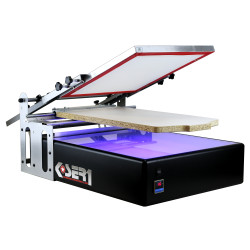The Ultimate Guide to Screen Printing Exposure Units – Get the Best Exposure for Perfect Prints
A screen printing exposure unit is an essential tool for creating high-quality stencils, ensuring precise details in your screen print projects. Whether you're using a tabletop exposure unit, a vacuum exposure unit, or an LED exposure unit, the right exposure system will help you expose the screen correctly for crisp, durable designs.
This guide will walk you through the different types of screen printing exposure units, their features, and how to choose the best unit for your screen printing process. Whether you’re a beginner or an experienced screen printer, investing in a high-quality exposure unit can elevate your screen printing projects and improve production efficiency.
Table of Contents
- What is a Screen Printing Exposure Unit?
- How Does a Screen Exposure Unit Work?
- Why is Proper Exposure Important in Screen Printing?
- Choosing Between LED, UV, and Fluorescent Exposure Units
- What is a Vacuum Exposure Unit and Why Do You Need One?
- How to Select the Best LED Exposure Unit for Your Shop
- Understanding Exposure Times for Different Emulsions
- The Role of Computer-to-Screen (CTS) Exposure Systems in Modern Printing
- Maintaining Your Exposure Unit for Long-Lasting Performance
- Where to Buy the Best Screen Printing Exposure Units?
What is a Screen Printing Exposure Unit High quality?
A screen printing exposure unit is a specialized unit designed to expose the screen by transferring a film positive image onto the screen that has been coated with emulsion. This step is essential in the screen printing process, ensuring that the stencil correctly holds ink during printing.
There are various types of screen printing exposure units, including:
- LED exposure units for fast exposure times and energy efficiency.
- UV exposure units for high-resolution details and halftones.
- Vacuum exposure units for precise contact between the stencil and screen.
How Does a Screen Exposure Unit Work?
A screen exposure unit uses a light source (such as LED bulbs, UV light, or fluorescent tubes) to harden the emulsion in areas not covered by a film positive. The process involves:
- Placing the coated screen into the exposure unit.
- Applying a blanket or vacuum to create a seal.
- Activating the exposure light to cure the emulsion.
- Washing out unexposed areas to reveal the stencil.
Why is Proper Exposure Important in Screen Printing?
Achieving the right screen exposure is critical for producing high-quality prints. Incorrect exposure times can lead to:
- Underexposure: The emulsion washes away too easily, ruining the stencil.
- Overexposure: The print loses crisp details due to excessive curing.
Investing in a quality exposure unit ensures opaque, long-lasting stencils.
Choosing Between LED, UV, and Fluorescent Exposure Units
Each exposure unit type has its own advantages:
-
LED exposure units:
- Energy-efficient with fast exposure times.
- Durable and long-lasting bulbs.
- Great for high-resolution stencils.
-
UV exposure units:
- Work well with all screen types.
- Deliver sharp prints with halftones.
- Ideal for high-detail designs.
-
Fluorescent exposure units:
- Economical for entry-level printers.
- Suitable for basic stencil exposure.
- Slower than LED exposure units.
Choosing the right unit depends on your screen printing projects and budget.
What is a Vacuum Exposure Unit and Why Do You Need One?
A vacuum exposure unit is designed for large-format printing and high-quality detail. It ensures the rest of the screen is held tightly against the film for precise exposure.
- Key Benefits:
✅ Eliminates light leaks with a compression get an exposure unit.
✅ Ensures sharp halftones and fine details.
✅ Works best with metal halide and UV light sources.
How to Select the Best LED Exposure Unit for Your Shop
A LED exposure unit is worth noting for shops looking for efficiency and top-tier service.
- Look for high-output LED bulbs for fast exposure times.
- Ensure compatibility with computer-to-screen (CTS) exposure systems.
- Check black light settings for optimal stencil clarity.
Popular brands like Ryonet and Workhorse offer industry-leading screen printing exposure units.
Understanding Exposure Times for Different Emulsions
Different emulsions require different exposure times:
- Fast-exposing emulsions: Work best with 500-watt bulb or LED light.
- Water-resistant emulsions: Need longer exposure times for durability.
- High-detail emulsions: Require controlled UV light exposure for crisp stencils.
Using the correct exposure system helps create top-tier prints.
The Role of Computer-to-Screen (CTS) Exposure Systems in Modern Printing
A CTS exposure system eliminates the need for film positives by imaging directly onto the screen.
- Advantages of CTS exposure units:
- Faster processing for high-volume screen printing projects.
- More economical by reducing film costs.
- High-resolution output for detailed prints.
Upgrading to a computer-to-screen system can help increase efficiency and expand capabilities.
Maintaining Your Exposure Unit for Long-Lasting Performance
To extend the life of your screen printing exposure unit, follow these maintenance tips:
- Regularly replace the bulb for consistent exposing your screen.
- Clean the glass and seal of vacuum units to prevent light leaks.
- Store in a light-safe darkroom to avoid accidental exposure.
Proper maintenance ensures the highest quality results for years to come.
Where to Buy the Best Screen Printing Exposure Units?
At Keygadgets Store, we offer a wide range of exposure units, including:
✅ LED exposure units for energy efficiency.
✅ Vacuum exposure units for high-resolution stencils.
✅ Tabletop exposure units for small shops.
✅ High-quality exposure units with fast exposure times.
???? Get the best exposure unit today and take your screen printing to the next level!
Key Takeaways
- A screen printing exposure unit ensures crisp, high-resolution stencils.
- LED exposure units provide fast exposure times and durability.
- Vacuum exposure units are ideal for detailed prints.
- Proper exposure times prevent stencil loss and ensure long-lasting designs.
- Computer-to-screen systems eliminate the need for film positives.
- Regular maintenance keeps your exposure system performing efficiently.
Looking for high-quality exposure units? Contact us today for expert recommendations!









